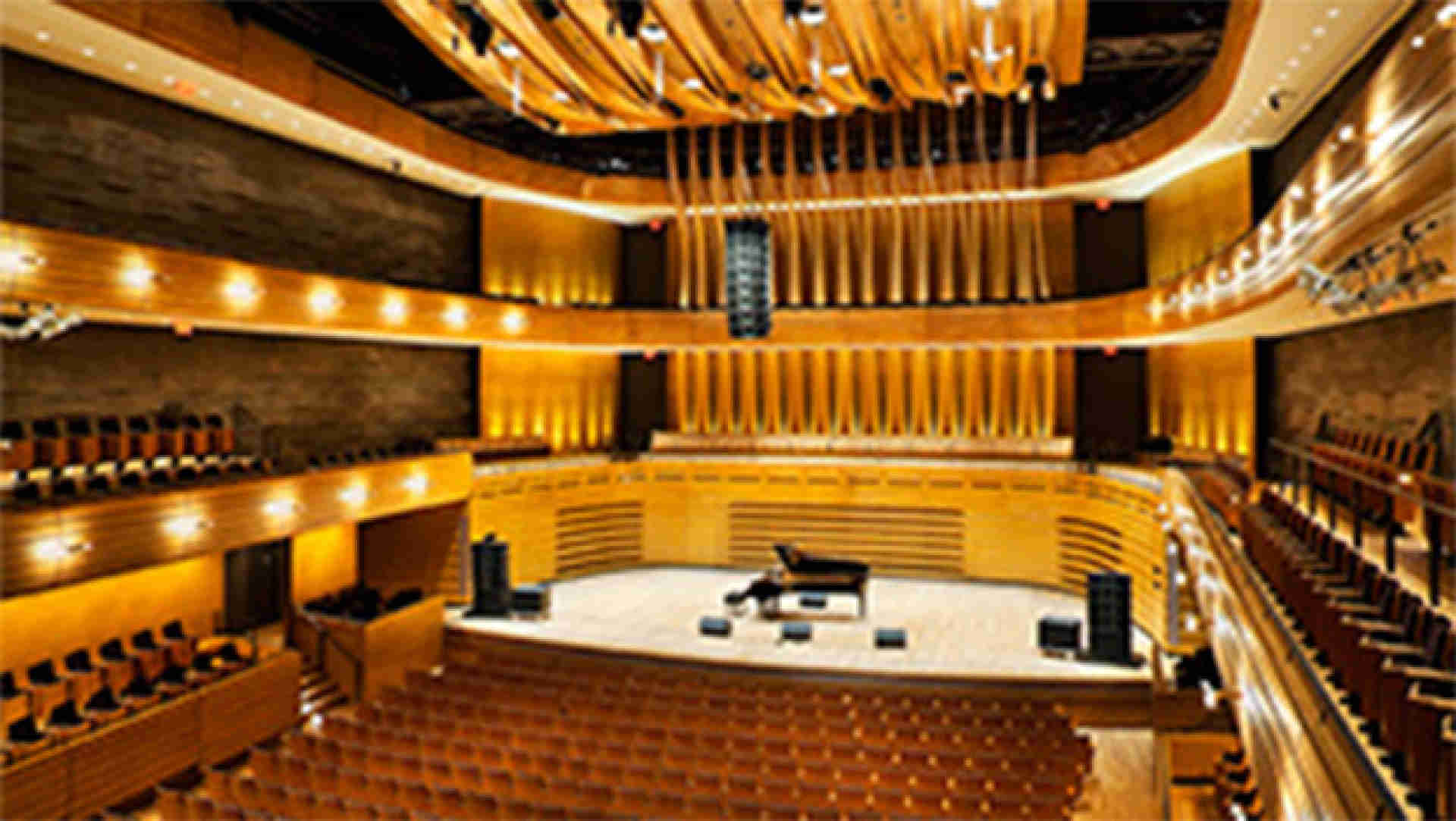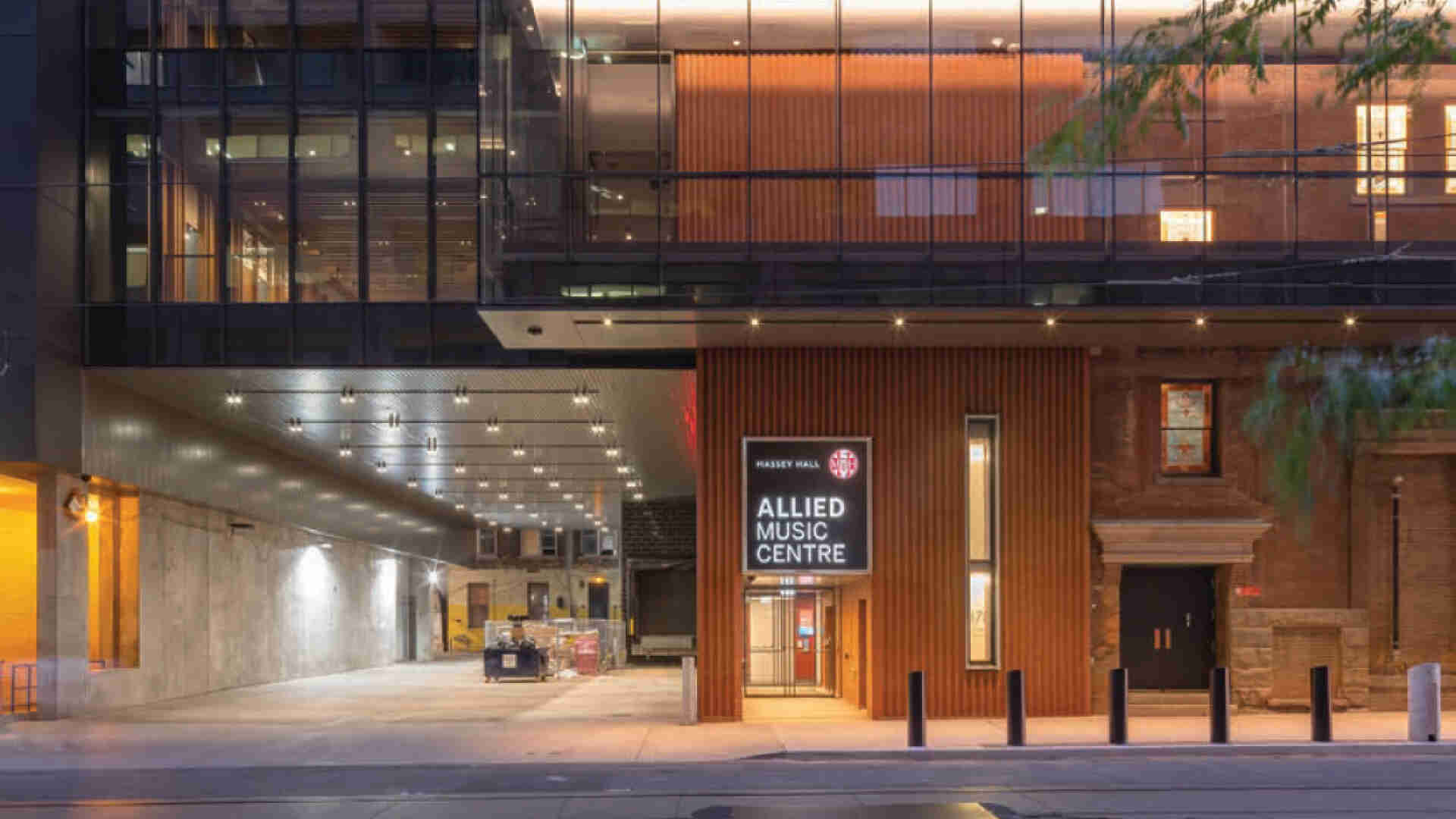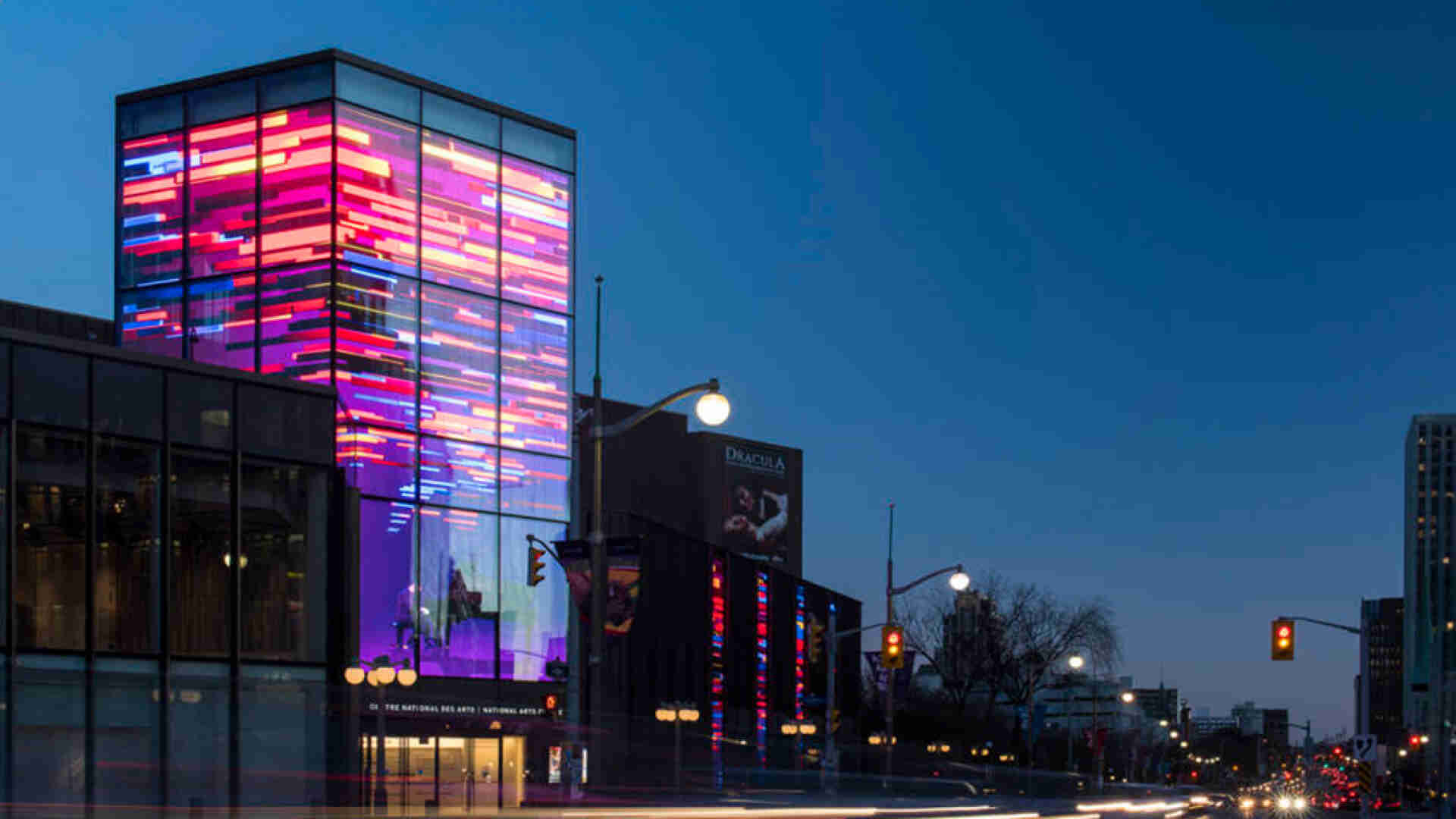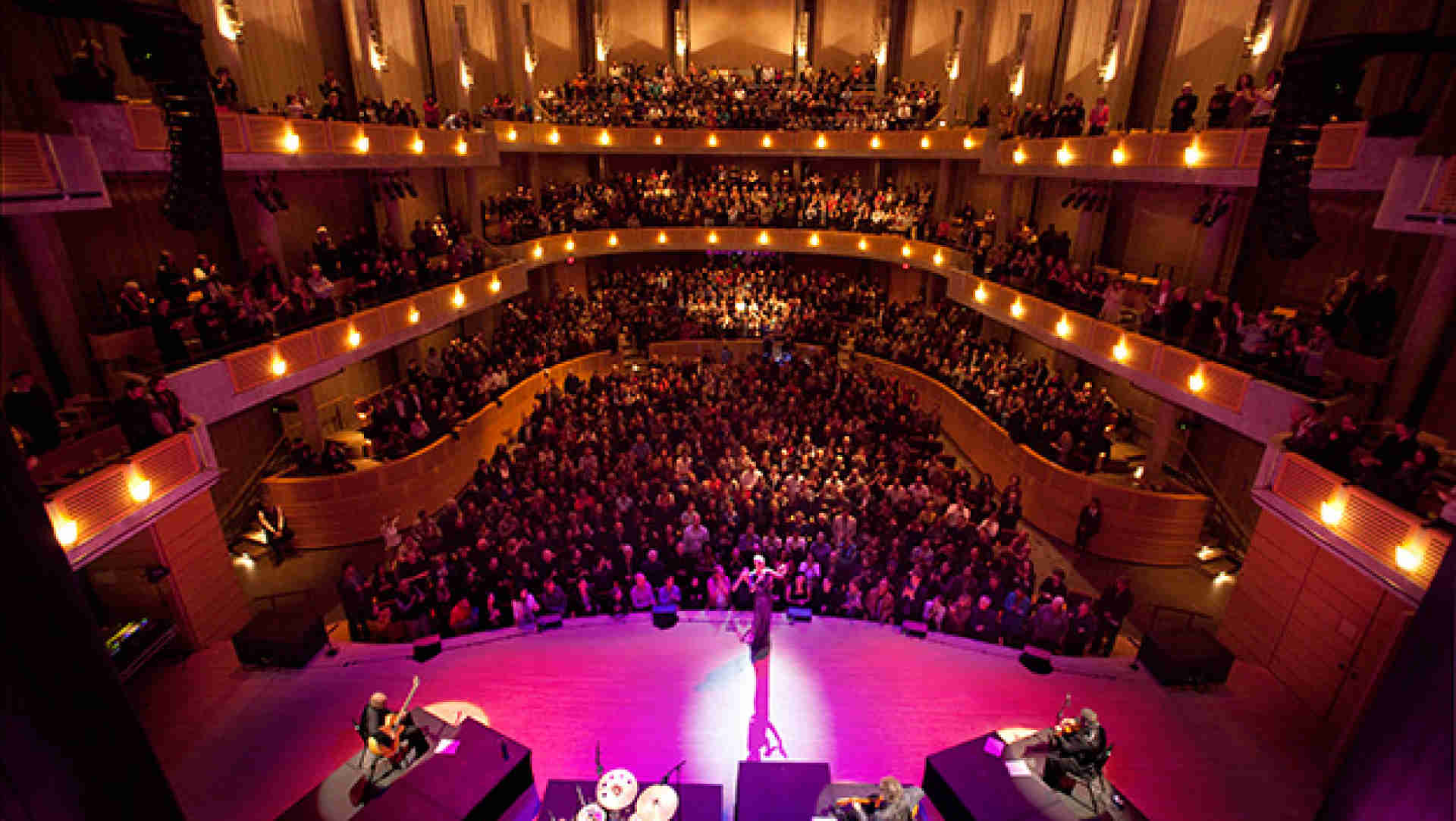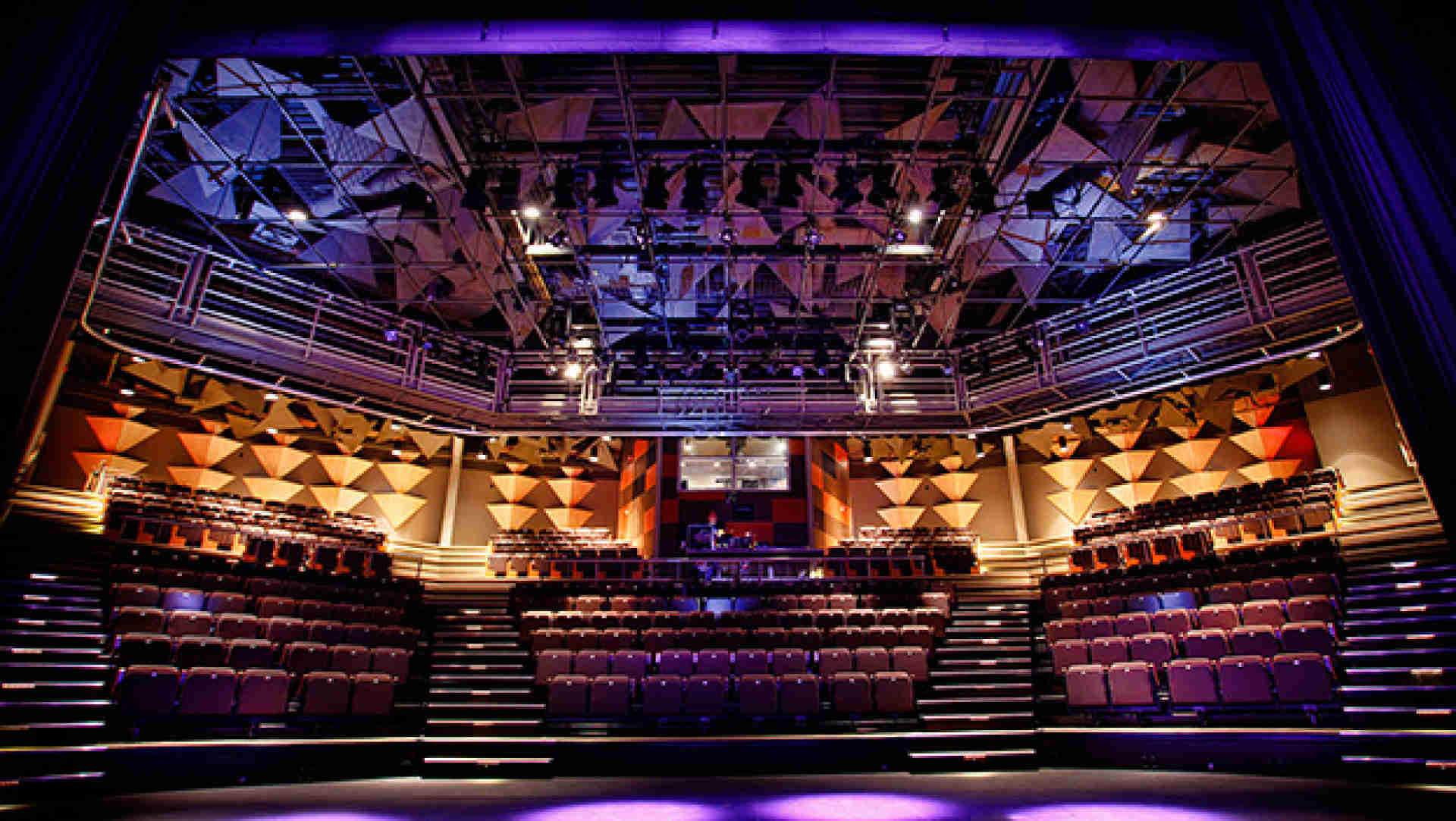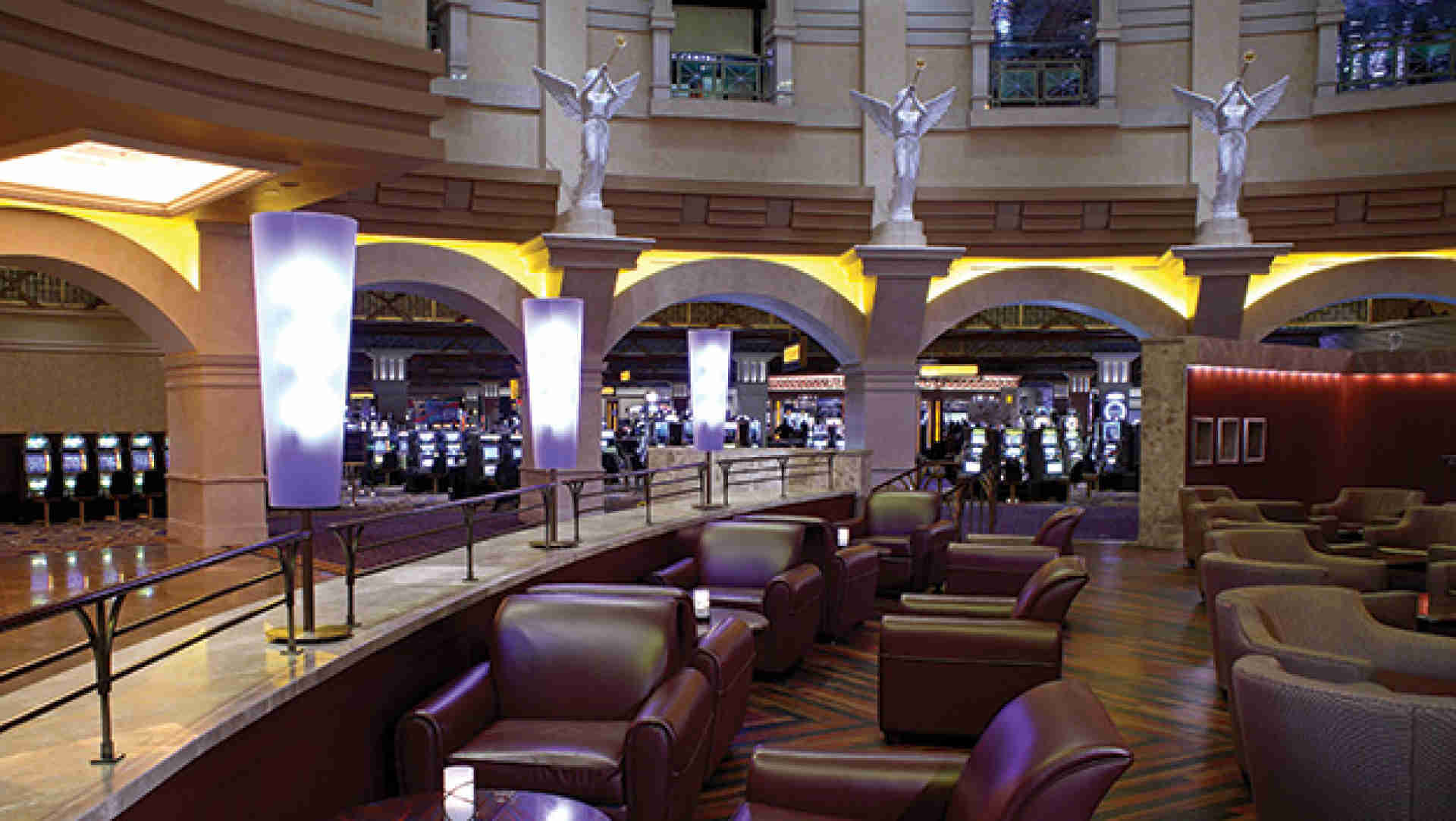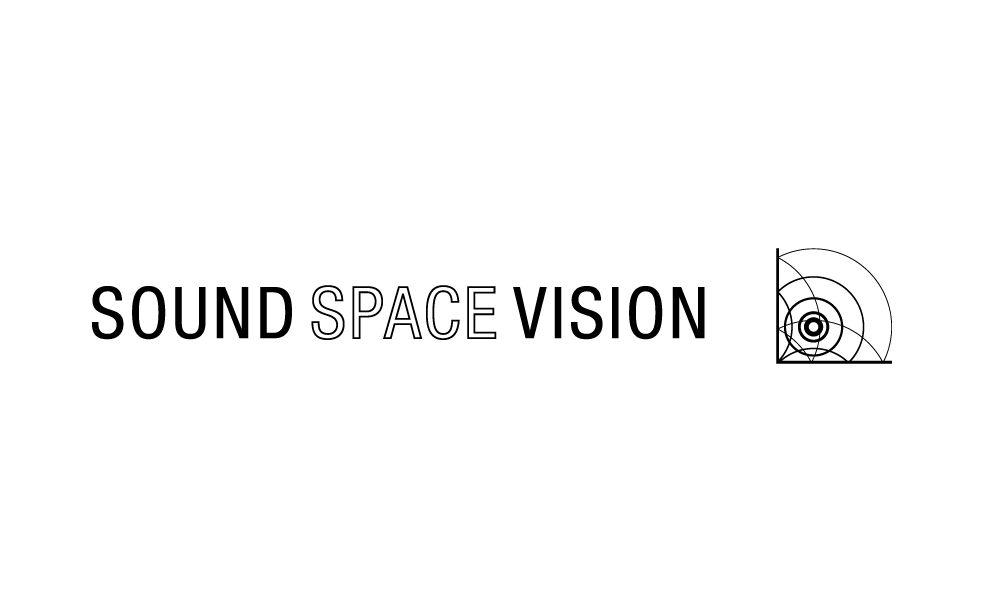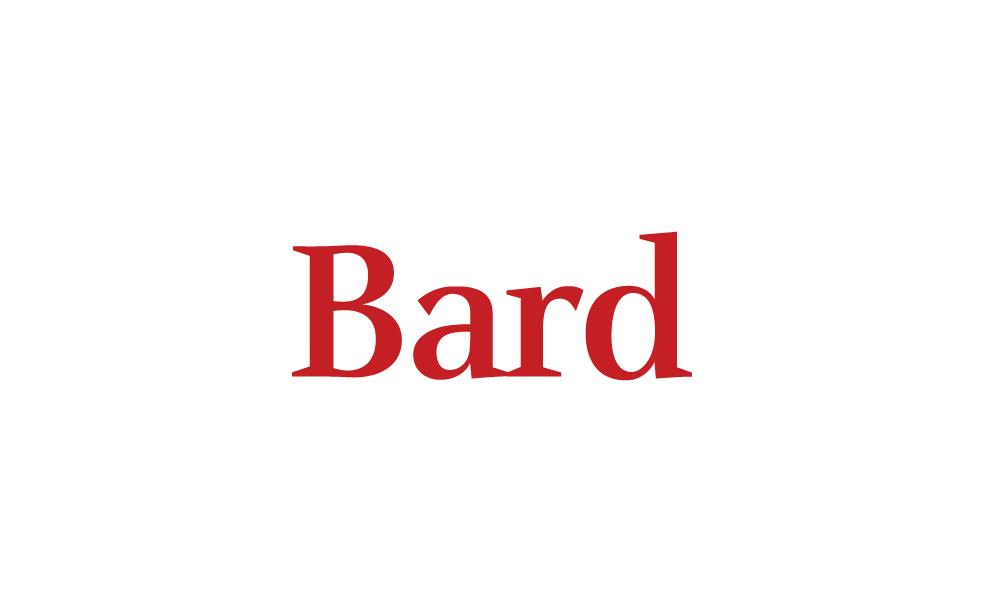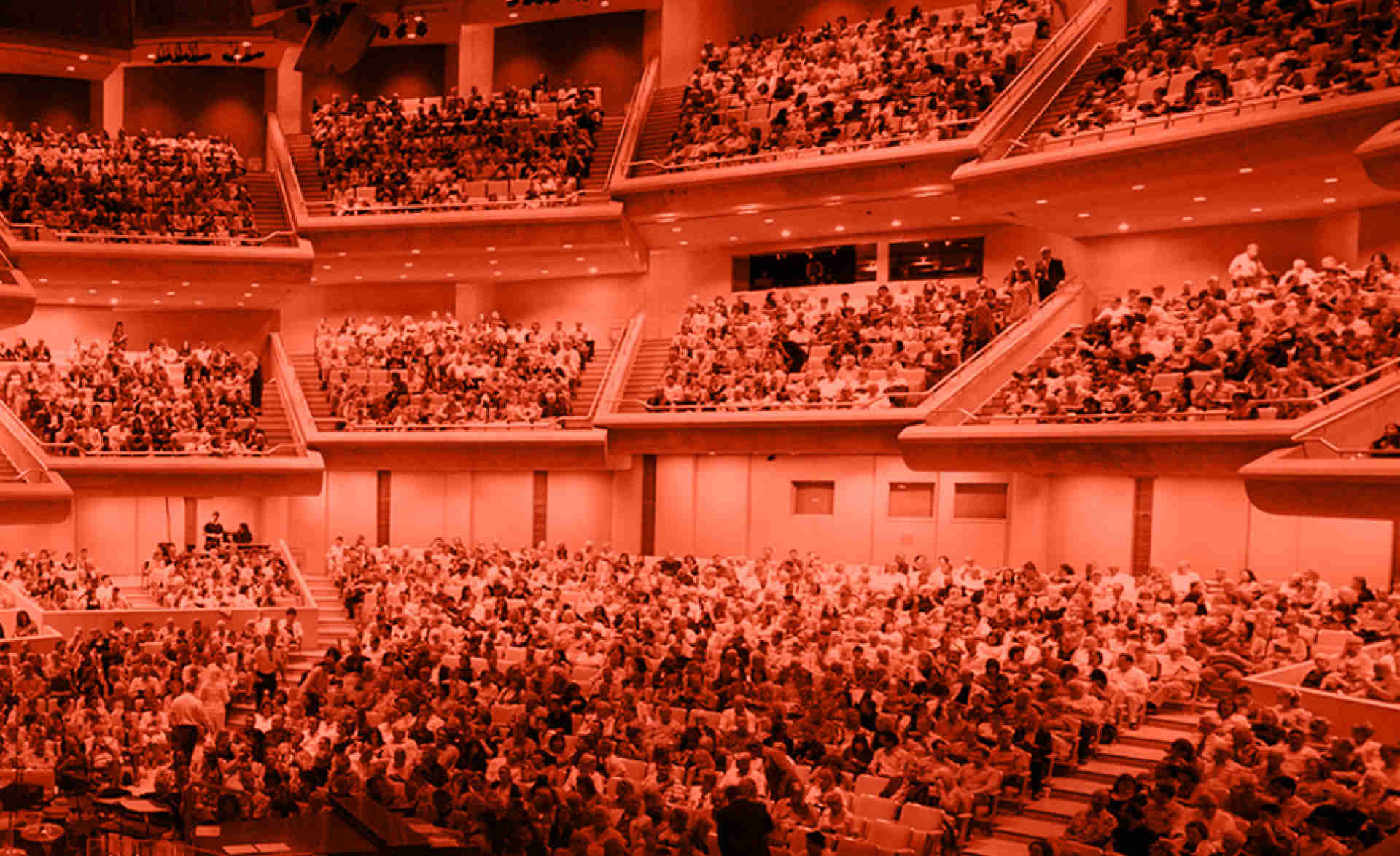The Integrated Sound System
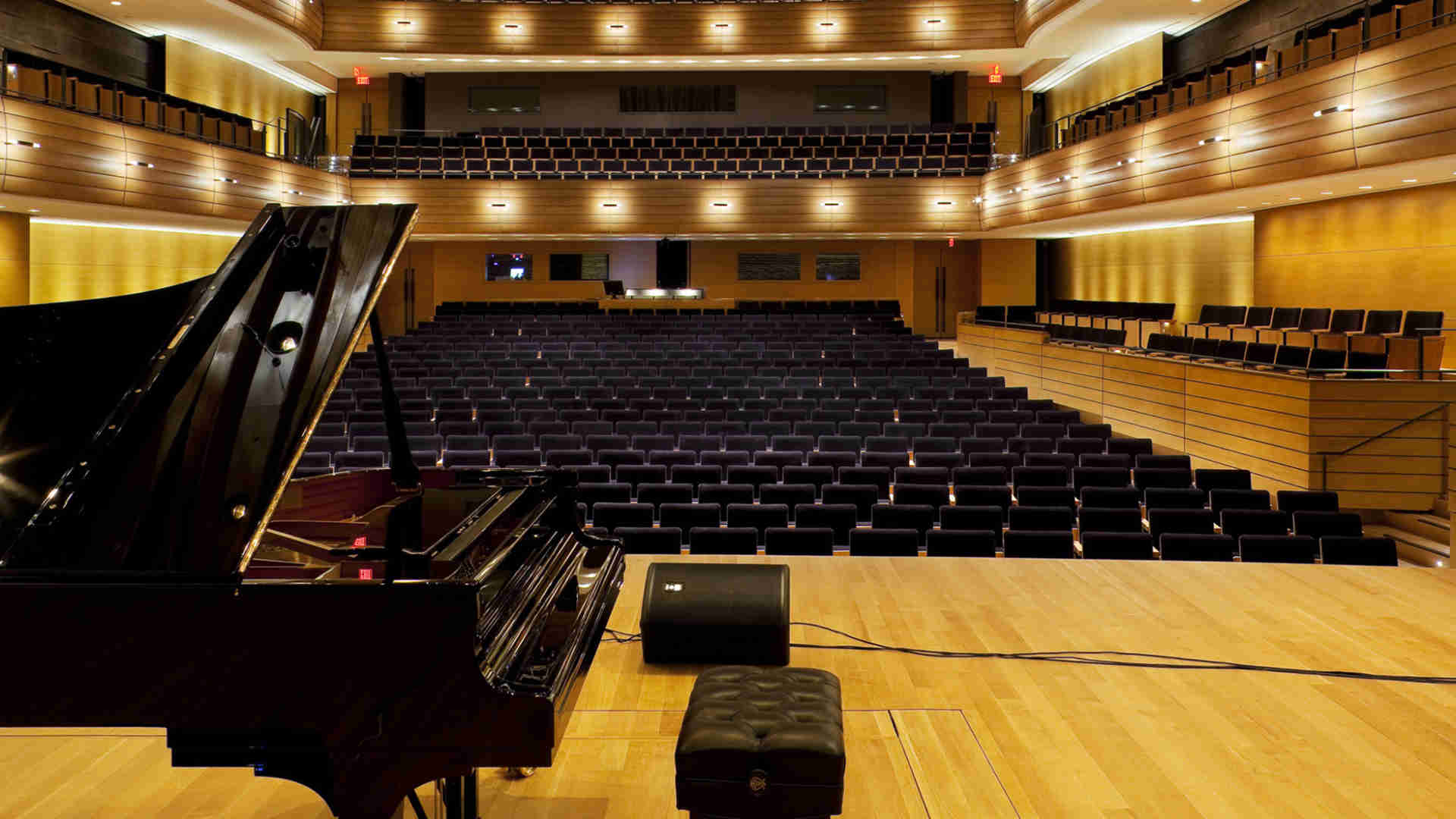
Combining voice-lift and performance sound functions at Toronto’s Koerner Hall
The new Michael and Sonja Koerner Hall at Toronto’s Royal Conservatory of Music (RCM), a beautiful and superb-sounding venue, features an innovative integration of its voice-lift and performance sound systems for use in reinforced applications where provision of complete coverage to every seat might otherwise be more costly or more complex to achieve.
The 1,135-seat concert hall is the jewel of the new TELUS Centre for Performance and Learning at the Royal Conservatory of Music, constructed over three years at a cost of some $110 million. While the conservatory’s mandate is centered firmly on teaching—more than 500,000 Canadians take part in RCM programs, exams, and public school initiatives in more than 300 communities across the country—the hall was built with an awareness of the power of performance to inspire and motivate music students.
Koerner Hall was also built to be an exciting new landmark on Toronto’s cultural map, not unlike Lincoln Center in New York with its constituent conservatory, The Juilliard School.
Situated in the heart of the city, steps away from the newly renovated Royal Ontario Museum, Koerner Hall is much larger than most school recital halls, yet is only half the size of a typical metropolitan concert hall. According to the project architect, KPMB, the venue “signals the expanded role of the RCM as a cultural destination for public enjoyment. With its distinctive interior and world-caliber acoustics, Koerner Hall will create a recognizable icon for the RCM, locally and internationally.”
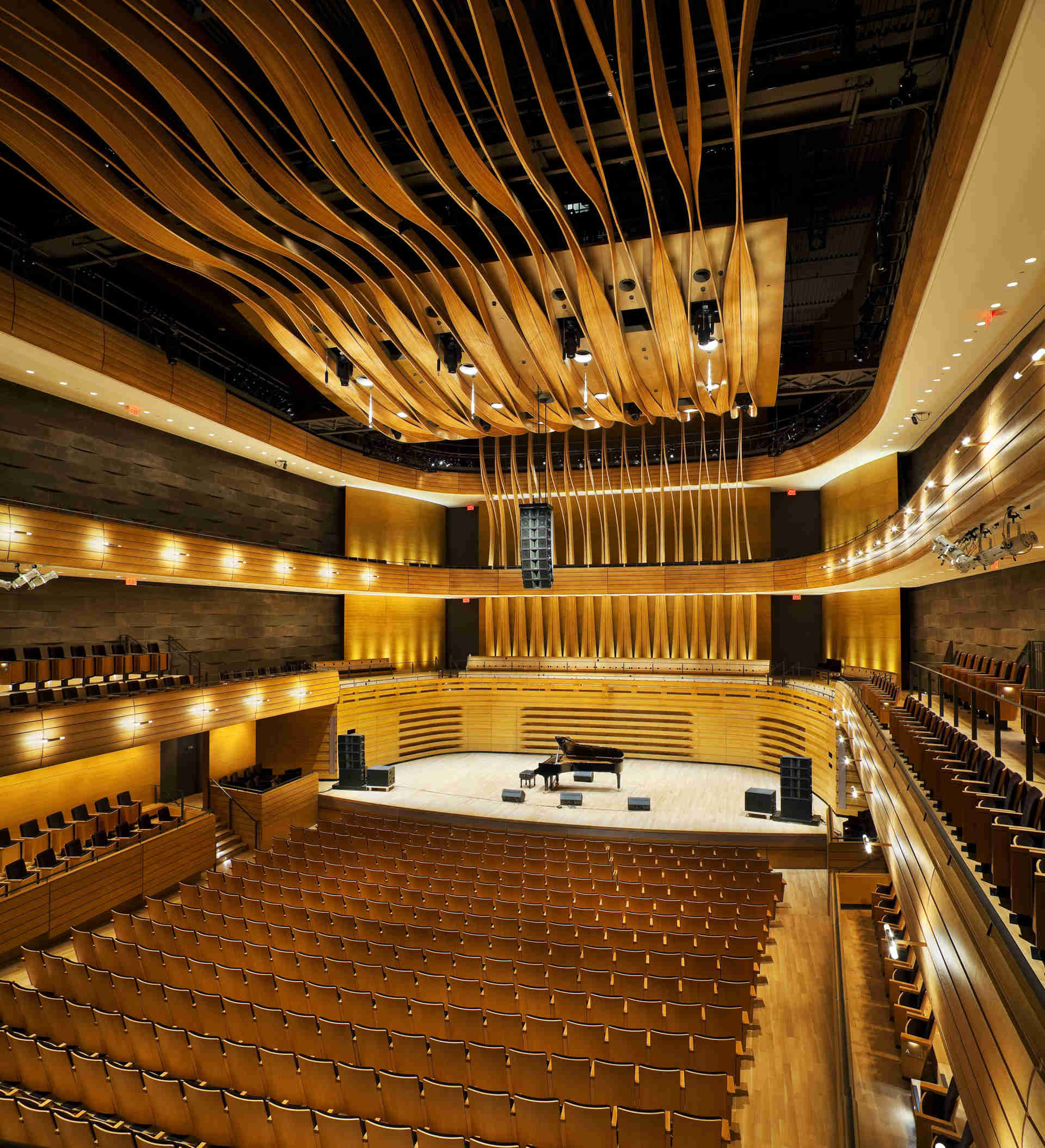
Koerner Hall showing center cluster – credit Tom Arban
Indeed, Telus Centre’s facilities extend well beyond those normally associated with educational institutions: It includes three tiers of glass-fronted lobbies, spacious back-of-house areas for performers, a café at the ground-floor level, and a unique collection of antique musical instruments donated by Michael Koerner. (Koerner, a venture capitalist, is a leading arts donor; he also helped to start the Encyclopedia of Music in Canada.) Each lobby level offers magnificent views of the University of Toronto, the museum, and the city, and is equipped with a bar and ample room to host a variety of functions related to concerts, conferences, and special events. The first-floor lobby, a three-story space with limestone floors, seats 200 diners. A glass room at the second lobby level is also available for meetings and private entertaining.
“Koerner Hall has all the features of much larger facilities, but scaled down,” says Martin Van Dijk, senior designer with Engineering Harmonics, the project’s audio-visual consultant. “It’s a gorgeous hall that can accommodate a lot of different programming, due to its variable acoustics. It has a really great intimacy and the sonic character to go along with it. Just to be in a hall like that is fantastic.”
Programming for the inaugural season reads like a Who’s Who of classical, world music, and jazz artists: The Emerson String Quartet, pianist Anton Kuerti, the Toronto Mendelssohn Choir, Ravi Shankar and his daughter Anoushka, Chick Corea, Stanley Clarke, and Bela Fleck are among the dozens of headliners featured this year.
Koerner Hall achieved the highest possible acoustic rating—N1—rendering it ideal for the finest acoustical performances of classical music, jazz, and world music, but the addition of variable acoustics by the acoustician Bob Essert, of Sound Space Design, makes it equally well-suited to amplified music, lectures, and film presentations. The hall’s design is based on the classical European shoebox format, and features two balcony tiers above the main orchestra level and a third technical balcony, finished to provide optimal sightlines for live televised broadcasts of performances.
The hall’s most visually striking feature is an acoustically transparent veil of twisting oak “strings” that form the backdrop for the chorus at the first balcony level, then hover over the stage below the fixed acoustic canopy and extend into and over the hall at the technical balcony level. The hall’s floors, as well as the balcony seats and fronts, are also finished in natural oak, which contrasts with the undulating black plaster panels that line the hall.
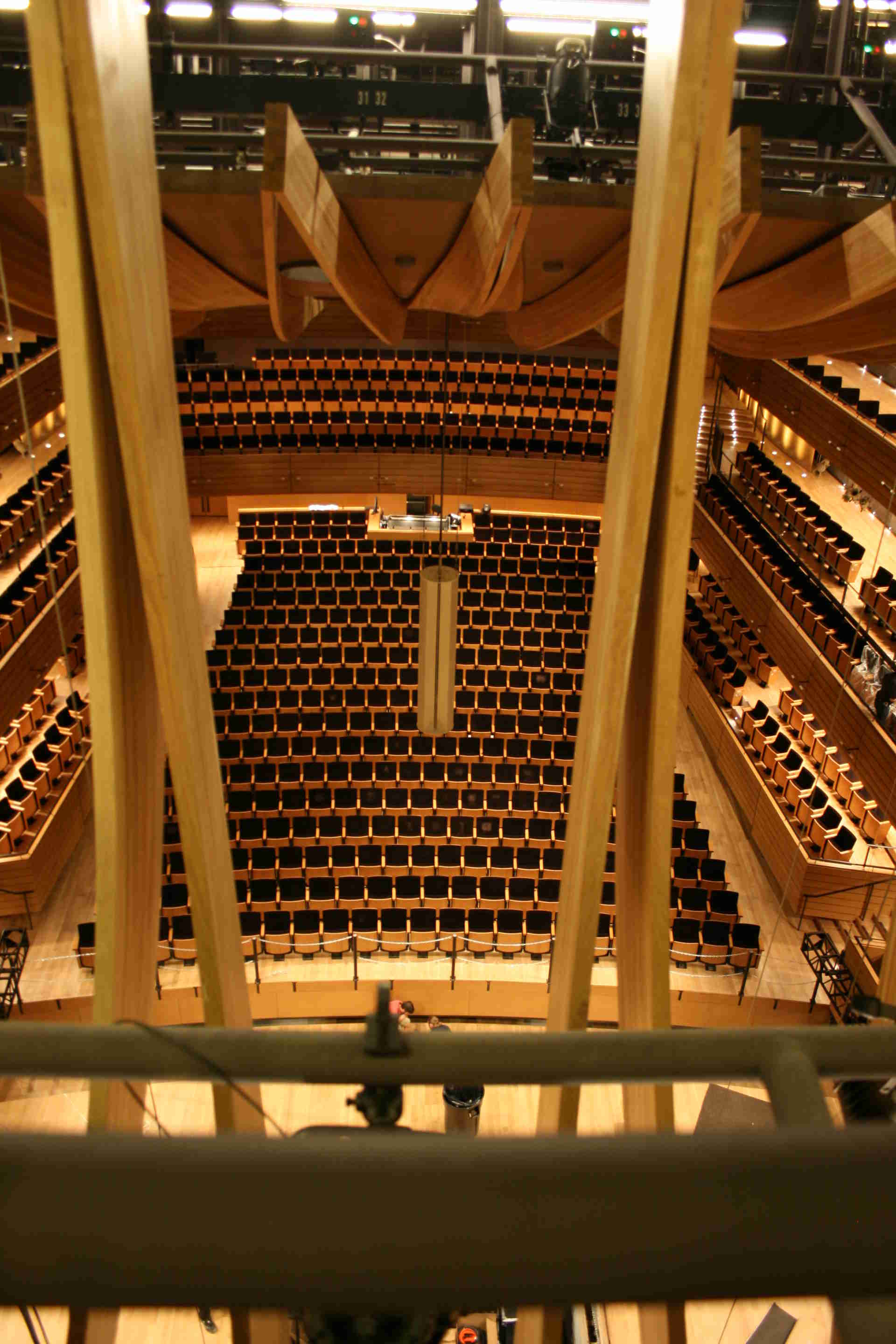
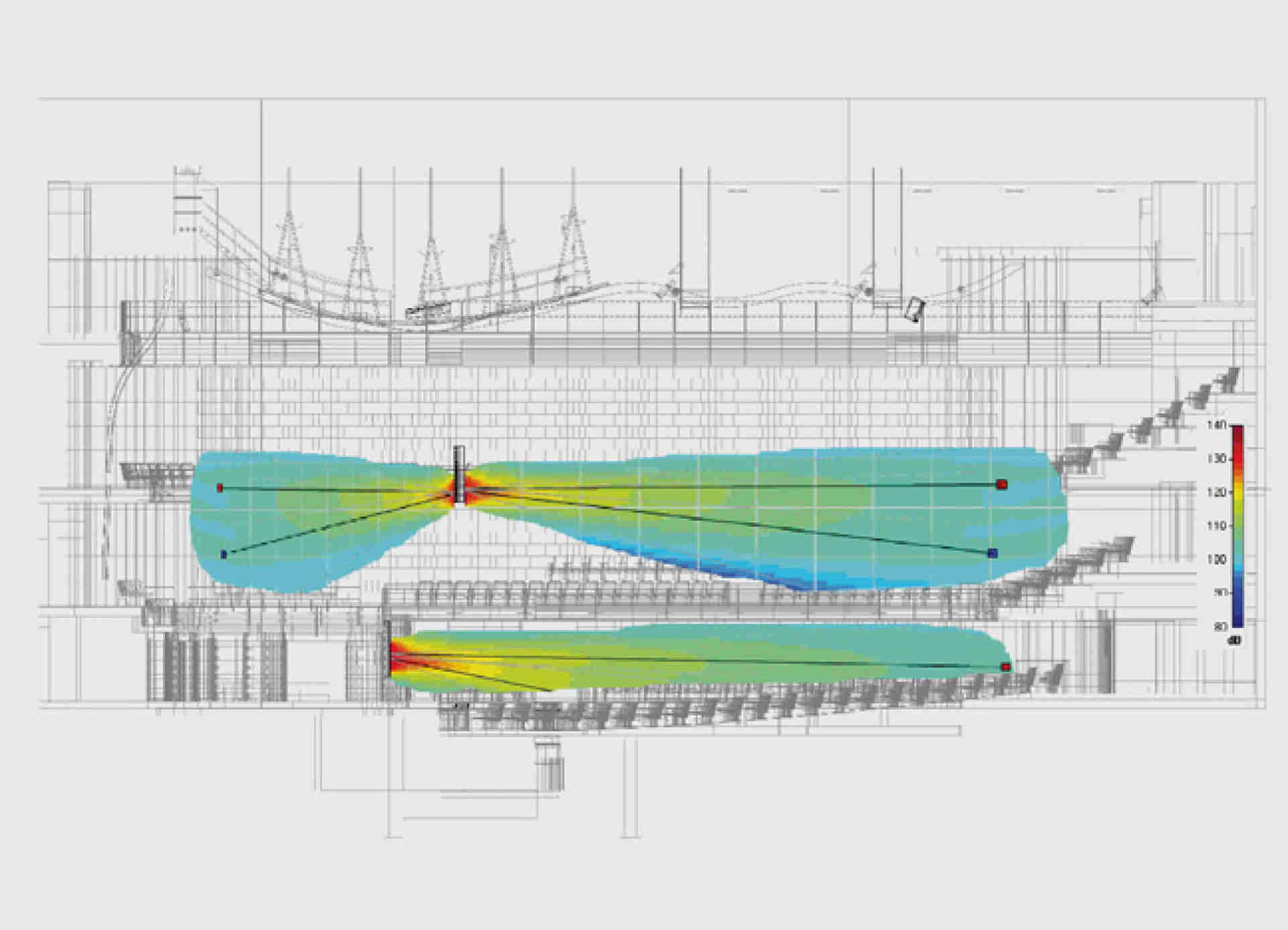
The voice stick, as seen from the rear of the stage – credit Bill Coons
Thanks to Renkus-Heinz’s BeamWare software, this drawing shows the sound radiation patterns from the hanging Iconyx voice stick (upper unit) and one of the two Iconyx arrays mounted in the front wall to the left of the stage.
The voice-lift system
“Concert halls need public address systems that are separate from any music reinforcement systems they may need,” says Philip Giddings, president of Engineering Harmonics. “Music systems tend to be large and fairly obtrusive, and, if they’re hung in the middle of a beautifully finished concert hall, they can be an eyesore. For announcements prior to or during a recital, or for lectures, you need something smaller and visually unobtrusive.”
To this end, Engineering Harmonics worked with Renkus-Heinz to design a unique, and almost invisible, retractable “voice stick,” comprised of three off-white R-H IC16 ICONYX digitally steerable array systems, just a little over 6’ high and arranged back-to-back in a circle 120° apart, sandwiched between two ¼”-thick aluminum discs, 18” in diameter and flown over the stage on a three-point hang from the top of the top plate.
The voice stick is augmented by two additional IC16 arrays, camouflaged behind acoustically transparent fabric in the front walls on either side of the stage.
Each IC16 is comprised of two IC8 enclosures, one mounted on top of the other, to provide sixteen 4″ drivers on each of the three sides of the voice-stick. The Iconyx system is unique in that each of the 16 discrete drivers in each array receives an individually filtered and delayed signal, enabling the array to produce up to eight independent specified vertical beams and steering angles up to ±30°. Because each IC16 in the voice stick can be configured to produce multiple beams, an upper beam can be aimed to provide coverage for the choir-level seating, while a lower beam can be programmed to cover the lower seating levels.
In the voice stick’s front-firing IC16, the upper beam radiates directly forward at 0°, within a vertical coverage angle of 10º (±5º up and down), and the lower beam radiates downward at -8º within a vertical coverage angle of 20º. This provides coverage for both first- and second-balcony seating.
In each of the two IC16s in the voice stick that are aimed at the back and sides of the hall, the upper beam’s radiation pattern is aimed slightly upward at +3.7º, within a vertical coverage angle of 15º to cover the upper level seating; the lower beam radiates downward at -12º, again within a coverage angle of 20º vertically, to provide coverage for the seats in the choir at the first balcony level.
In each of the two IC16s mounted in the front wall at either side of the stage, the upper beam radiates ever so slightly downward at -1.5º, within a vertical angle of 10º to provide coverage for the orchestra and parterre seating; the lower beam is aimed downward at -14º, within a vertical coverage angle of 20º to provide front fill.
Beamware control software communicates with the loudspeakers via RHAON (Renkus-Heinz Audio Operations Network) to permit adjustment of coverage, as well as the loudspeakers’ apparent acoustic centers, without physically moving the array itself, in order to improve localization of the sound source. Power cables and the Rhaon control cable are threaded up through the center of the voice stick behind the three Iconyx columns.
“With the voice-lift system, we are trying to provide intelligibility, not sound reinforcement,” Van Dijk says. “In a reinforcement situation, you want the loudspeaker to perform and to have the directivity to project sound energy exactly where the people are sitting. You are not really working with the acoustics of the room—in fact, most of the time, the acoustics of the room detract from amplified music. With a voice-lift system, on the other hand, you are most definitely working with the acoustics of the room. It’s a real challenge for a loudspeaker designer to find that compromise. In my experience, you can’t achieve that with solely one speaker system. I’ve been designing with dual types of systems over the past several years. Yes, there is a cost, but the proof is in the end result.
“When you’re listening to a solo voice and the room is acoustically live with all the curtains retracted, the sound is lifted from the stage and brought wonderfully out into the house,” he continues. “Because the voice stick is located directly over the center of the stage, it works very well with the acoustics of the room, with all the reflections that lift the voice off the stage and make it sound good. The lift and apparent image blend seamlessly; there is no cognitive dissonance due to audio not localizing with the performer visually. If I had used a more conventional array, it would have been difficult, if not impossible, to get that lift without hearing it as a point source, with an accompanying tonal shift arising from the loudspeaker itself imparting its own character to the sound, by virtue of its geometry and size.”
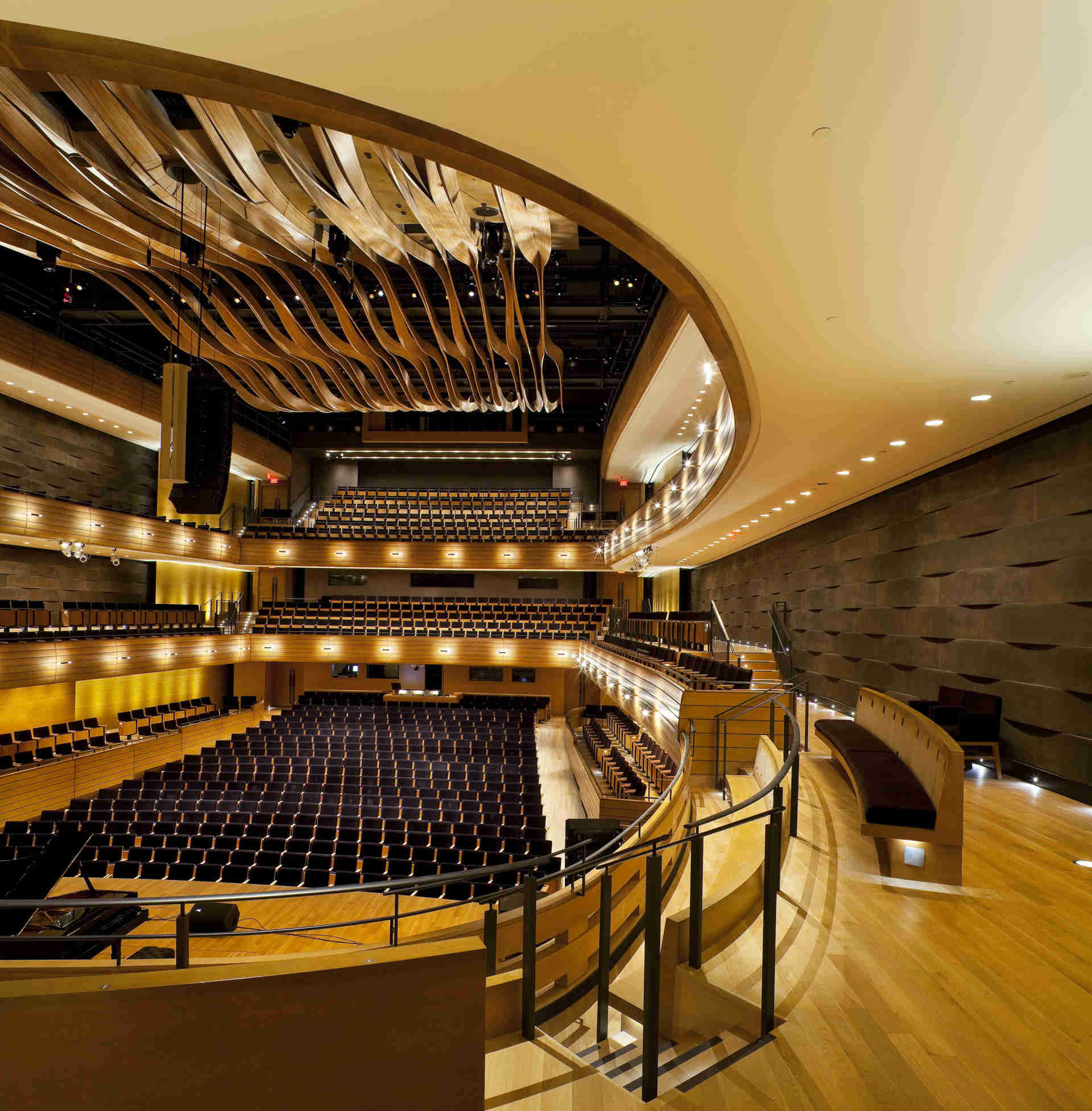
Koerner Hall showing voice-stick behind center cluster – credit Tom Arban
The sound reinforcement system
The sound reinforcement system for amplified performances consists of a single retractable, center line-array comprising eight JBL VERTEC VT4887A compact bi-amplified three-way loudspeaker systems, augmented by two VerTec VT4881A subwoofers hung in the canopy.
The VerTec center cluster covers a portion of the orchestra level all the way up to the top balcony. Coverage for the front of the orchestra is provided by seven Renkus-Heinz SGX41 loudspeakers concealed in the stage lip, or, alternatively, eight SGX41s in the lip of the pit lift when that is deployed. The SGX41 loudspeaker was selected because it uses the same coaxial transducer as the Iconyx IC16, and is therefore an appropriate match to the main system.
Two Renkus-Heinz SGX121s, mounted in the catwalk, provide delayed over-balcony fill, as do a pair of Tannoy CMS401DCe loudspeakers at the sides of the parterre level. All passive loudspeakers are powered by Crown IC series amplifiers.
For occasional use in very demanding applications, additional loudspeaker systems can be rolled onto stage left and right, each consisting of four VT4887ADP powered compact, bi-amplified loudspeakers, and a pair of VT4881ADP powered subwoofers.
For most reinforced applications, however, the voice-lift system can be integrated with the flown performance sound system to provide complete coverage of the orchestra level and the seating in the chorus levels above the sides and rear of the stage.
Integrating the two systems
When both systems are deployed, the voice stick hangs mere inches behind the center cluster, and this is where the design gets really interesting. “Rhaon allows for the front-firing IC16 in the voice-stick to be switched off; otherwise, it would fire right into the back of the center performance cluster, explains Bill Coons, director of Contact Distribution, Inc., supplier of the Renkus-Heinz equipment to Koerner Hall.
“This leaves the other two IC16s that aim at 120° and 240° to provide coverage for those areas to the sides and rear that the performance sound cluster does not address,” he says.
The center cluster is essentially omnidirectional at low and low-mid frequencies, so those parts of the spectrum wrap around to the sides and rear somewhat, and integrate with the mid and high frequencies from the two rear-side units in the voice stick.
“This alleviates the need to mount a rear-firing unit to the back of the center performance cluster that would have compromised the rigging’s straightforward design and the ability to retract the cluster into the ceiling,” says Coons. “Engineering Harmonics consistently thinks outside the box to maximize a design’s flexibility and budget allocation, and this design is a first, to their credit.
“The intimacy of the seats in the chorus is well served by Iconyx’s near-audiophile quality,” he adds. “Furthermore, the IC16s at stage left and right can achieve significant performance levels suitable for something like a jazz sextet when augmented by a single performance system subwoofer on each side. An IC16 can deliver 99dB SPL at 100’.”
“The IC16s don’t really have to throw far, so it all works reasonably well,” says Van Dijk. “If it’s particularly loud on stage, then you might find that there’s not as much power as you might want, but that was a design decision that was taken in the context of some of the compromises that were made. But now that word is out about how good it sounds, and Koerner Hall has become recognized for its quality and uniqueness, everybody wants to book it, including acts with heavily amplified, full monitor-rig shows. That wasn’t its original purpose, but it’s the same for any venue: If you build it and it’s great, they will come!”
“The voice-stick is an innovative and visually elegant solution for any room that does not have a proscenium,” Giddings says. “And the integration of the sound reinforcement and voice lift systems is nothing short of brilliant.”
The house mix position and sound control room
Yet another design innovation was the provision for a permanent mix position at the rear of the parterre level on the centerline, just steps from the door to the sound control room located house right of the centerline (symmetrical with the lighting control room situated house left).
The house mix position comprises a wheeled dolly for sound equipment, a bulkhead that houses tie lines for microphones, analog and digital audio (including CAT6 and fiber-optic cable), intercom, and performance video. A cable pass for temporary wire sets to the sound control room and demountable seating are also provided.
All permanent sound equipment is housed in a rack room at the rear of the sound control room, with the exception of hearing-assistance transmitters and amplifiers that power passive loudspeakers with the associated DSP; these are housed in an amp rack room up on the fourth level next to the dimmer room.
“They expended the money and effort to have a permanent mix position—something that is missed on so many projects—which we strongly recommended and coordinated closely with the architect,” says Van Dijk. “It’s fantastic, because it accommodates touring professionals who may be unfamiliar with the venue, giving them a comfortable place to mix that’s right there in the hall.
“Secondly, for a teaching facility, it’s preferable that the house mix position is always there,” he says. “People can come in and work with whatever is going on in the venue, and get a good sense of what they’re doing. You could sit in a control booth and be teaching someone about sound, but it’s not the same as being immersed in the sound environment and hearing it naturally. You can’t really learn about sound very well when you’re removed from it in a booth. Now students can go back and forth from the mix position to the booth, where the main equipment is housed. Alternatively, they can do smaller reinforced events from the booth. We’ve tried to integrate the monitors—which are properly delayed to coincide with arrival times from the stage—so that the monitoring level reflects what’s going on in the hall, and they get a sense of accurate levels. If it’s too loud in the booth, it’s probably too loud in the hall.”
A four-channel monitor feed is derived from the Soundcraft Si3 64-input digital house mixing console; there is no separate monitor console or large splitter system that would be required to go along with it. Additionally, the Si3 allows saving and recalling of shows as necessary.
“For budget reasons, we originally specified a Yamaha M7CL, one of the most commonly encountered digital consoles,” says Van Dijk. “Due to its price-performance design, it doesn’t offer all the bells and whistles that touring professionals might want to use. Granted, many of these people will bring in their own console, but from a facilities standpoint, the client wanted something with improved microphone preamplifier performance. The Si3 was born of the Studer Vista series consoles, and you definitely hear that sound quality. The Yamaha M7CL offers a fantastic feature set, but it’s more about functionality than it is about sonic quality, and is offered at a correspondingly lower price.”
A further requirement was the capability of recording in-house recitals and events for practice and review, as well as archiving. Two Sennheiser MKH-416 shotgun microphones suspended from the catwalk provide a program sound feed, which is split into a USB microphone preamplifier connected to a dedicated MusicXPC computer in the sound control room for recording to hard drive immediately. Van Dijk says “I love the XPCs because they’re quiet; you can put them in the room with you and they work.”
A broadcast-quality Hitachi DK-H32 camera feeds an HD signal via HD modulators to flat panel displays deployed in the lobbies and back of house, and to a low-noise Dell PC, which is fitted with an Extron HDSDI-ACR 100 video capture card and simple recording software for archiving. This setup permits capture of a high-quality stereo audio and video feed of a recital or concert, which can then be burned to DVD.
“The HD camera provides an impressive broadcast quality image. Digital signage content will augment the video for display on the flat panels at some point in the future,” Van Dijk says.
Yet another innovation is the incorporation of network infrastructure for collaborative music events and programs with other schools in Canada and the U.S. “They are working with McGill University in Montreal, for example, to hold remote recitals. You may have a master class recital with a MIDI-actuated piano on the stage in Koerner Hall, and on a retractable screen you’ll see live video of a pianist sitting in McGill’s studio and playing a MIDI-equipped piano. The MIDI data will be streamed in real time from Montreal to the piano in Koerner Hall some 500 km away, and you’ll hear it in all the acoustic splendor of Koerner Hall,” Van Dijk explains.
“In future, they see real-time musical collaboration as a reality. To make it as close to real-time as possible, they’ll be using a dedicated data path and will know exactly what the propagation time is. This is the Telus Centre, after all, and Telus has guaranteed a certain allotment of bandwidth and capability, so the highway is there. Now they just have to come up with the things to plug into it.”
